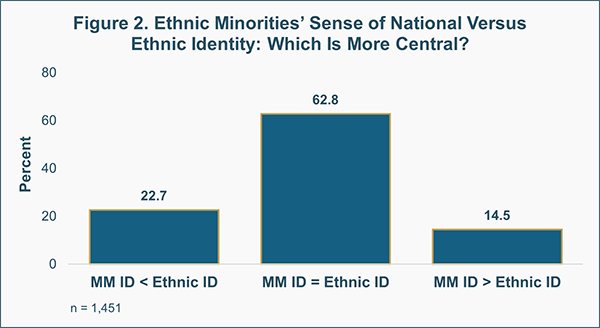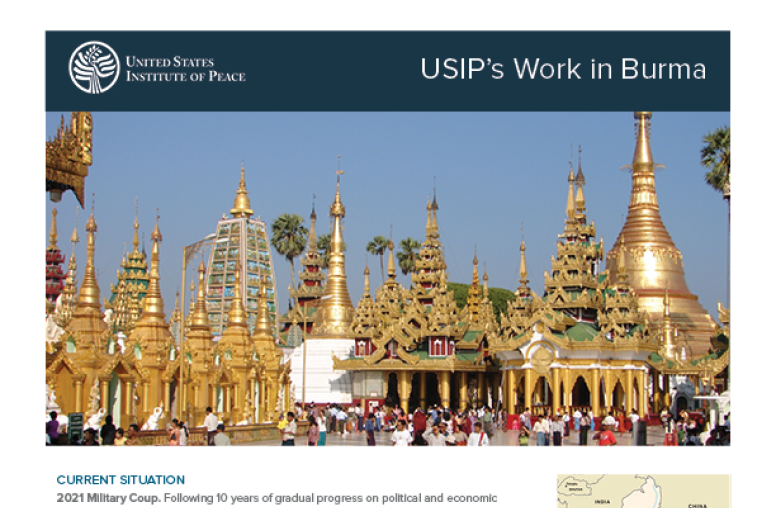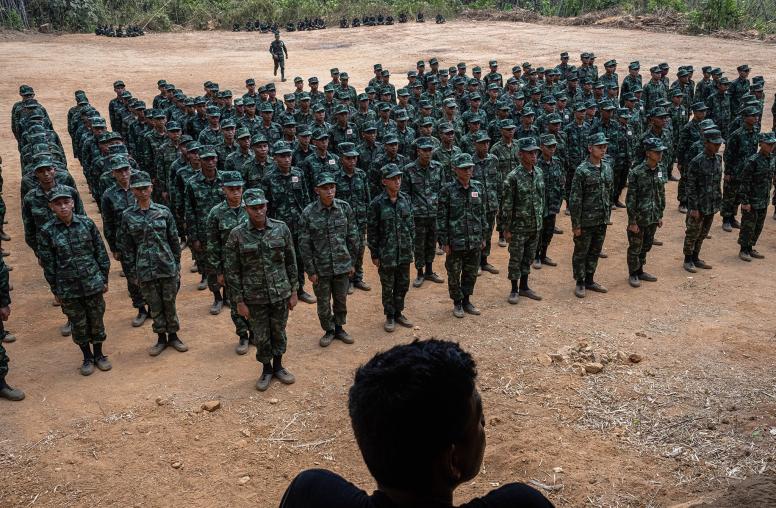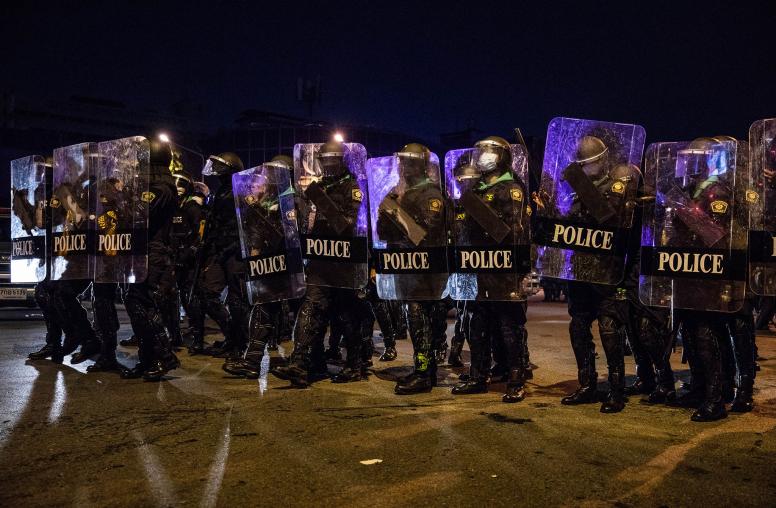Myanmar: New Data Show Wide Support for Unity Government
A survey finds diverse ethnic groups backing the anti-junta coalition — a promising basis for stability.
The three-month offensive by Myanmar’s alliance of disparate ethnic armed groups has weakened the military regime more than at any time since it seized power three years ago. This highlights a question for international policymakers: Could the anti-coup forces stabilize Myanmar? New public opinion data bolsters evidence that the National Unity Government (NUG) — which combines representatives elected in the 2020 election and ethnic minority leaders — has a solid basis to lead such an effort, holding strong popular support across Myanmar’s numerous ethnic groups. Such stabilization will depend on the NUG’s ability to deepen its inclusivity and responsiveness and broaden its political coalition.

The new research, a survey by the authors of 4,612 Burmese adults from diverse ethnic groups, suggests broad popular support for a national union. (The study relies on an “online opt-in sample” — a group of individuals who opted to take a one-off survey while online, and thus not representative of the Myanmar public.) The survey indicates that the NUG is well placed to initiate a rebuilding of Myanmar as a peaceful, multiethnic nation-state, a goal that would best be served through a federal democracy. Such a process would require the NUG and the various ethnic-based forces fighting military rule to pursue serious political dialogues that have been slow up to now.
Such dialogue on a future political and governing structure grows in urgency as the resistance forces’ advance heightens the possibility of the junta’s collapse. This is because, alongside the finding of broad support for the NUG, the survey also highlights a risk: Myanmar’s many ethnic minorities continue to fear prospects of any government dominated by the Bamar majority, and the population widely perceives the NUG as Bamar-dominated. This only amplifies the urgency of building dialogue and trust among the NUG and the many ethnic-based organizations resisting military rule. An armed ouster of the junta in the absence of such a robust, resilient and inclusive political dialogue would create tremendous uncertainty and increase the probability of fragmentation and disorder.
The international community should significantly increase the minimal humanitarian, technical and financial assistance currently reaching the pro-democracy movement and beleaguered populations. It should also support intra-resistance dialogue efforts and avoid efforts that could divide the movement.
New Data — and What We Can Learn
Analysts and policymakers have lacked rigorous data on the Myanmar public’s perceptions about leadership and governing legitimacy within the pro-democracy movement — a gap that has constrained international support for that movement and for political dialogues vital to future stability. With USIP’s support, the authors conducted an online survey, between April and August 2023, of the global Myanmar public. (The project advertised the survey on Facebook and recruited research assistants who helped distribute the survey to various ethnic communities.) Burmese living in 20 countries participated, nearly 47% of them in Myanmar, Malaysia, Singapore and Thailand (Table 1). They came from nearly two dozen ethnic communities, half of them identifying as Bamar (see Table 2).
The Myanmar diaspora’s attitudes matter hugely for their homeland’s future. Burmese abroad are committed stakeholders in Myanmar’s political processes (70% of respondents to the survey are Myanmar citizens; others are stateless or citizens in their countries of refuge). News reports reflect that Myanmar’s diaspora is the “single most important source of funding” for the resistance movement and at the “forefront of activism in response to the coup.”
Five key takeaways from our survey are these:
1. Support is strong and broad for the NUG. Nearly 92% of respondents (including 93% of Bamars and 91% of ethnic minorities) felt “somewhat” or “very” favorable toward the NUG, with comparably high support from within Myanmar and the diaspora. That support translates into action: Those favorable toward the NUG are 26% more likely to donate money to the resistance and humanitarian efforts and 60% more likely to buy bonds issued by the NUG compared to the 8% who are unfavorable. This massive support for the NUG reflects the Myanmar people’s resolute objection to the military regime. As a survey respondent noted, “Burmese people…want to end the root cause of the longest civil unrest and war, which is the military dictatorship.”
2. Support for the NUG is also high in those ethnic communities whose armed organizations are not formally aligned with the NUG. Some ethnic armed organizations have joined forces with the NUG but many have not. While support for the NUG is greater among communities of groups aligned with the NUG, support for the NUG is nevertheless high among communities of the groups not aligned with the NUG — 86.4% felt “somewhat” or “highly” favorable toward the NUG. Responses from the ethnic Rakhine community, which is centered in northwest Myanmar, are noteworthy. That community’s armed force, the Arakan Army, has vowed to create a sovereign “Arakan Nation” and is not openly aligned with the NUG, though it tacitly supports the resistance movement. Yet our survey data found Rakhine respondents as likely as others (from the Chin, Kachin and Karenni minorities) to contribute to the NUG’s fundraising efforts, reflecting strong support for the NUG even from a minority group formally unaligned with it.
3. Ethnic identities are not necessarily divisive. The survey reflects the historically powerful role of ethnic identity in shaping Myanmar’s politics: 83.3% of ethnic minorities described their ethnicity as “somewhat” or “very” important to their identity. Among some ethnic groups like Chin, Kachin and Karen, this number is well over 90%. While literature on nationalism often assumes that ethnic and national attachments compete with one another, this survey shows them positively correlated. Fully 77.3% of respondents from Myanmar’s ethnic minorities described the importance of their Myanmar identity as equal to or greater than their ethnic identity. In other words, ethnic minorities with strong attachment to their ethnic community also have strong attachment to Myanmar. This suggests that ethnic identity in Myanmar politics is not necessarily a divisive force.
4. Most minority citizens reject ethnically fractured political landscape. Many minorities favor the NUG more than their own ethnic armed organizations. Fully 78% of respondents from ethnic minorities favored the NUG as much (51.4%) or more (26.6%) than their own minorities’ armed groups. Just 22% favored their own ethnic armed organizations more than the NUG. Not surprisingly, among ethnic minorities without an armed group (including Chinese and Indian communities), only 12% favored ethnic armed organizations more than the NUG. This is effectively a broad declaration of most minority citizens for a union rather than an ethnically fractured political landscape.
5. A political risk: Many Burmese see the NUG as dominated by the majority Bamars. While survey responses favor the NUG overall, they differ in a key respect. Among Bamars, as the importance of their ethnic identity increases, their support for the NUG also increases. But the effect is opposite among ethnic minorities, whose support for the NUG declines as the importance of their ethnic identity increases. Among those who feel their ethnic identity is important (83% of the ethnic minorities and 69% of Bamars), minorities are less favorable toward the NUG than Bamars. While subtle, these shifts raise the question whether the NUG is viewed as a Bamar-dominated institution. Similar trends exist along religious lines. Religious minorities strongly support the NUG — 91% are “somewhat” or “very” favorable — but the highest level of support comes from Bamar Buddhists.
Implications for Myanmar’s future
The undeniably strong public support for the NUG across all segments of Myanmar society suggests the potential of the NUG and any successor to lead the process of rebuilding Myanmar as a multiethnic nation-state. Yet public opinion, however resounding, cannot forge a federal democracy. That will require the NUG and the various ethnic armed organizations to engage in political dialogues and cooperation.
While military cooperation is clear between the NUG and the ethnic armed groups, political cooperation is less so. Just four such groups — the Chin National Front, Kachin Independence Organization, Karen National Union and Karenni Progressive Party — are openly aligned with the NUG. Political dialogue among the main groups is crucial now as they make military gains across Myanmar, making the junta’s collapse seem more plausible than ever. An agreement on a postwar political arrangement among the NUG and various resistance groups is necessary to ensure Myanmar’s future stability.
The ethnic minorities’ lingering concerns about a Bamar-dominated government, and the evidence that the NUG is perceived by many as Bamar-dominated, means the NUG should urgently evaluate how to build trust with those communities and better accommodate their interests. A survey respondent wrote, “The NUG is the leadership we have right now therefore [I] am happy to support however I can, but they may need to come up with some decisive actions…and quickly while they still have people's support…”
If this survey’s results reflect ethnic minorities’ collective vision, the data reveal broad support for a national union, not fragmentation. The ethnic armed organizations owe it to the communities they represent to engage in conversations about the future of Myanmar and negotiate for the kind of union their communities want.
Almost three years since the coup, a new political paradigm in Myanmar is no longer an elusive dream. Decisive actions from the NUG and the ethnic armed organizations can bring the country a step closer to stability and a clear path toward a durable peace.
Dr. Jangai Jap is a postdoctoral fellow in the Department of Government at the University of Texas at Austin. Dr. Amy H. Liu is professor in the Department of Government at the University of Texas at Austin. The authors thank the United States Institute of Peace for funding this research. We are also grateful to Ja Moon Latt, Jan Jan, Naw Rose Min, Ohn Mar Zin, Phyo Ei Htwe, Sarah Tin-U, Sung Chin Par, and Aung Myo Hein for research assistance.






